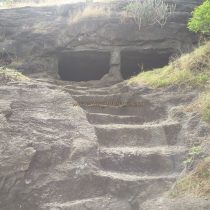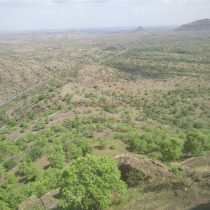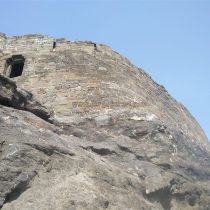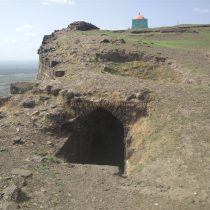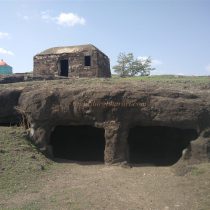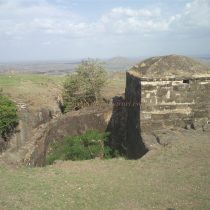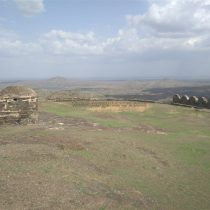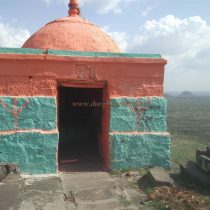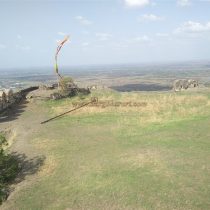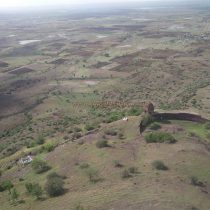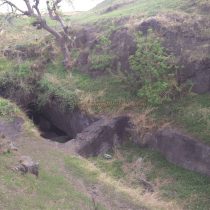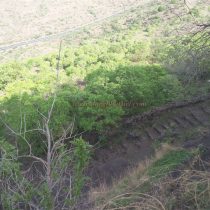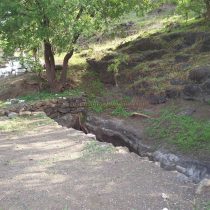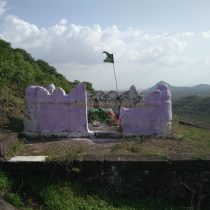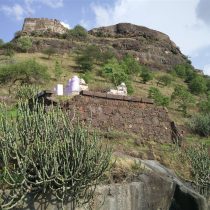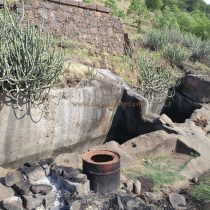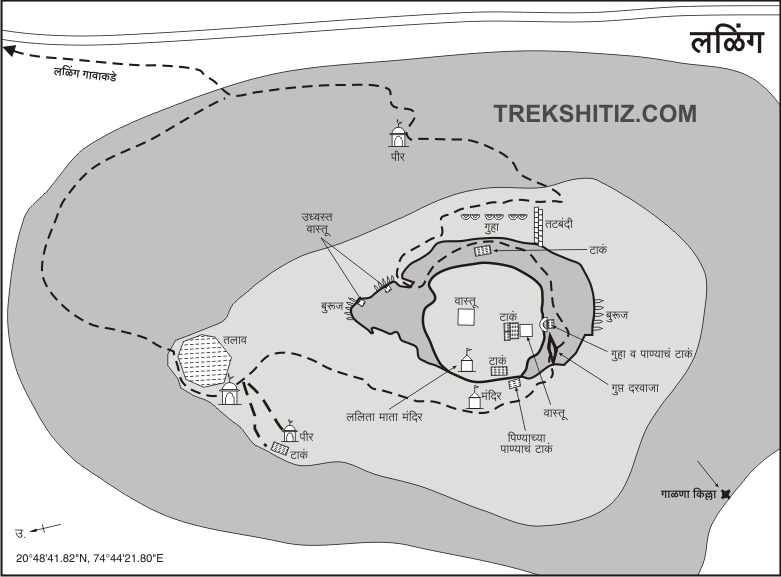LALING
TYPE : HILL FORT
DISTRICT : DHULE
HEIGHT : 1865 FEET
GRADE : MEDIUM
Laling Fort is the tallest fort in Khandesh after Bhamer fort on the border of Baglan and Khandesh on the Nashik-Agra highway. One of the most beautiful forts in North Maharashtra, this fort was the capital of Khandesh in medieval times. In Laling village, only 8 km away from Dhule city, this fort is rich in its remains and can easily be seen in half a day as it is close to the highway. The fort is divided into two parts, Machi and the citadel. On the way to the fort from Laling village, you can see the ancient Shiv temple built in black stone. The remaining walls of the temple and the carvings on the doors still show the splendor of the temple. There is a water tank behind the temple and there is a path leading to the fort near this tank. As there is no water facility on the fort, adequate water should be kept with yourself before starting the trek.
...
As the locals come and go to the fort, the way to the fort is visible and there are directional signs on the way to the fort. Looking up from here, the huge white bastion on the right side of the fort catches your eye. From here you would start your trek by keeping the fort and ramparts on the right. There are small plants with fewer leaves along the way. After about half an hour of climbing, you get to the stone steps broken by the flow of rainwater. After climbing these steps, you will see a tomb and a cistern in front of you. Looking at the piles of stones on both sides of the footpath, this place is likely to be the first gate of the fort. From here the left path leads to the citadel and the right path leads to Machi of the fort. Going further from the left, on the way you can see four or five caves carved in the rock which prove the antiquity of the fort. These caves may be used for storage or living. From here the road on the left goes out of the ramparts while the road on the right goes directly from the ramparts to the main gate. Leaving the caves behind, we come to the collapsed main gate of the fort. On the right side of the door, you can see a carved shrabh on the wall. These sculptures are of both, Hindu and Muslim architectures. There is an office of the fort in front and today only the walls and rooms of the building remain. When you come up from here, you can see the ramparts and bastions of the fort on the right and a place for the cannon on top of it. The range of this cannon includes down to the north side of the fort. Looking down from this bastion, one can see a lake that is currently dry and the domed structure on its edge. This is the place where you can see a decorated arched wall that was constantly catching your eye while climbing from the base of the fort. It is built in the style of Muslim architecture using bricks and lime. This building, which looks magnificent from the outside, is unpredictable from the inside as it has collapsed. A new flagpole has been erected in front. From here you can see the Mumbai-Agra highway and Dhule city and also see the fort of Songer when the weather is clear. Beyond this bastion, you can see the five-six arches that add to the beauty of the fort, and you can come back to the gate and go to the other side of the fort from the left. Along the way, there are three water cisterns built in the rock, which contain water even in summer. Although this water smells bad, the same water is used for drinking by the people coming to the fort but it does not feel drinkable. From here onwards there is the plateau of the citadel and on this plateau, you can see the quadrangle structures of some houses. On this plateau, you can still see some water cisterns carved in the rock. The ramparts around the plateau have been buried in the soil up to the curtain wall and the designer stone on these ramparts is still in good condition. In some places, arches are seen on the ramparts. From this rampart, many forts like Pisolgad, Kankrala, Dermal, Galna can be seen from the south-west. There are some caves dug in the belly of the pinnacle on the plateau and water cisterns are carved in them. There is a building in the upper part of the pinnacle, which is probably an ammunition depot. At the back of this depot is a large cave with three water cisterns carved into the rock. Adjacent to these water cisterns is a square basin built of black stone. In front is a small temple of Lalitmata. If you want to stay at the fort, you can stay in this temple. But it can only accommodate two people. There are some quadrangle structures in front of the temple and there is a large quadrangle structure of a mansion in it. After passing through the ramparts, we reach the secret gate on the west side of Laling fort. The ramparts that lead to this gateway are still in good condition. The path leading down through this door leads to the fort. Going down through this door, you come across a water cistern carved in the rock. After descending a little from here, the path turns right. On the way, there is a fallen temple of Goddess. The path in front of the temple leads straight to Machi. There is a large lake on this machi and there is a domed tower on its edge. The octagonal lake is simple but the tower built on one of its corners gives it a different beauty. There are two water cisterns in front of the tower. On the upper side of the cistern is a tomb and there is a dilapidated Mosque with two tombs over here. Machi of the fort is fortified in some places. From this area, there is a beautiful view of the fortified bastions of the fort and the semi-circle designs on them. We should explore the Machi by keeping the lake on the right and go up further. This path again takes you closer to the ruined entrance. This is where your two-hour long fort round to the top of Laling fort ends. After seeing all the surroundings, go back to Laling village. Among the historical dynasties of Maharashtra, the Farooqi dynasty of Khandesh is one of the dynasties. This family ruled over Khandesh for two hundred years. In the year 1370, Malik established the kingdom of this Farooqi dynasty. From 1370 to 1399, King Malik of the Farooqi dynasty ruled Laling. After Malik died in 1399, Laling came under the control of his eldest son Nasir Khan and this area became the center of power of the Farooqi dynasty. Nasir Khan gave the fort the status of capital and Laling became the capital of Khandesh. The importance of this fort is underscored by the fact that Malik gave the fort to his eldest son instead of Thalner. In 1400, Nasir Khan conquered Asirgad, established a city called Burhanpur, and declared it his capital. Later, in 1435, a battle was fought between Bahmani Sultan and Nasir Khan. In this battle, Nasir Khan was defeated. After the burning of Burhanpur by the Bahamani Sultan, Nasir Khan again took refuge in the Laling fort, but the army of the Bahamani Sardar Malik-ul-Tujar pursued him and reached the Laling area. At that time, Nasir Khan himself came down from the fort and with the help of 2000 cavalry and innumerable infantry, he attacked the Bahmani army. There was a great battle at the foot of Laling but Nasir Khan was defeated and had to return to Laling fort. In this war, the Bahamani chief got 70 elephants and a huge amount of wealth. So, without falling into the trap of taking Laling fort, he took the loot and left for Bidar. This defeat fell on the shoulders of Nasir Khan and he fell ill and died on 17 September 1437 at Laling fort. The fort was captured by the Mughals in 1601, ending the Farooqi dynasty. After the expansion of the Mughal Empire into Baglan and Khandesh, Laling became their major military base. In 1632, the fort of Galna near Malegaon came under the Mughal rule with the courtesy of the fort keeper of Laling. In 1632, Mir Qasim was the Mughal fort keeper of Laling. The Galna fort near Laling was under Nizam rule at that time and Mahmud Khan, the fort keeper there, had decided to hand over the fort to Shahaji Raje. When this news reached Khanjaman, the Subhedar of Khandesh, Khan wrote to Mir Qasim, the fort keeper of Laling, to persuade Mahmud Khan to not let the fort fall into the hands of Shahaji. Mir Qasim performed this important task and persuaded him and added the fort to the Mughals. After the Marathas defeated the Nizam in the battle of Bhalki in 1752, Laling joined the Marathi Empire. The Peshwas handed over the fort to Malharrao Holkar. After the defeat of the Maratha army by the British in 1818, Laling came under the control of the British.
© Suresh Nimbalkar



